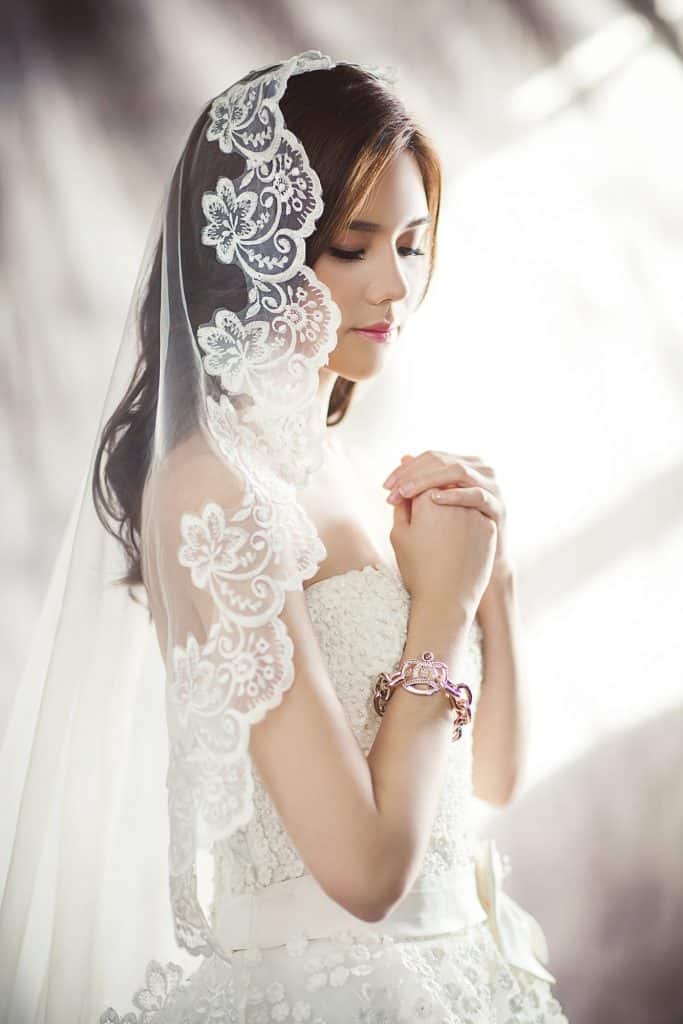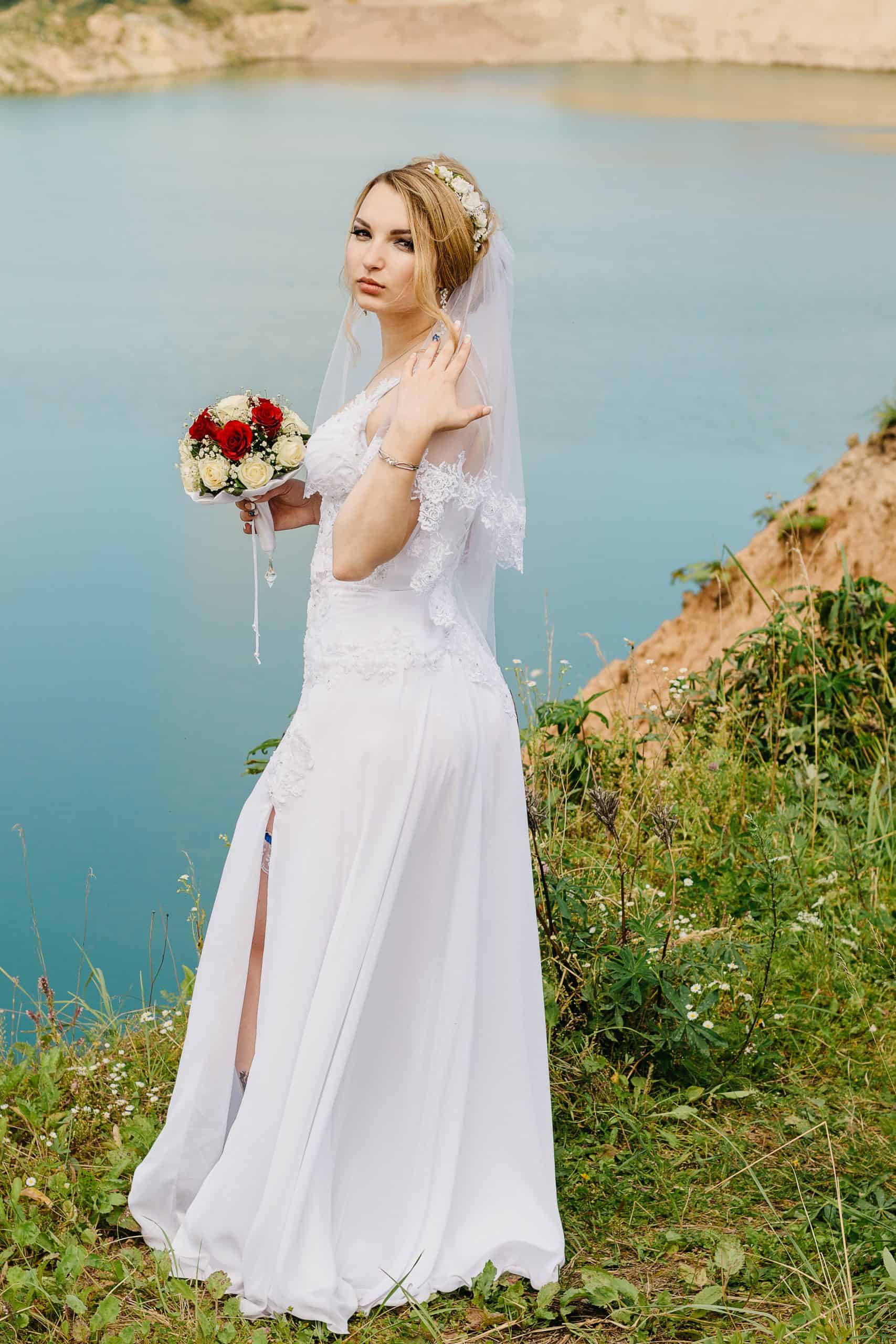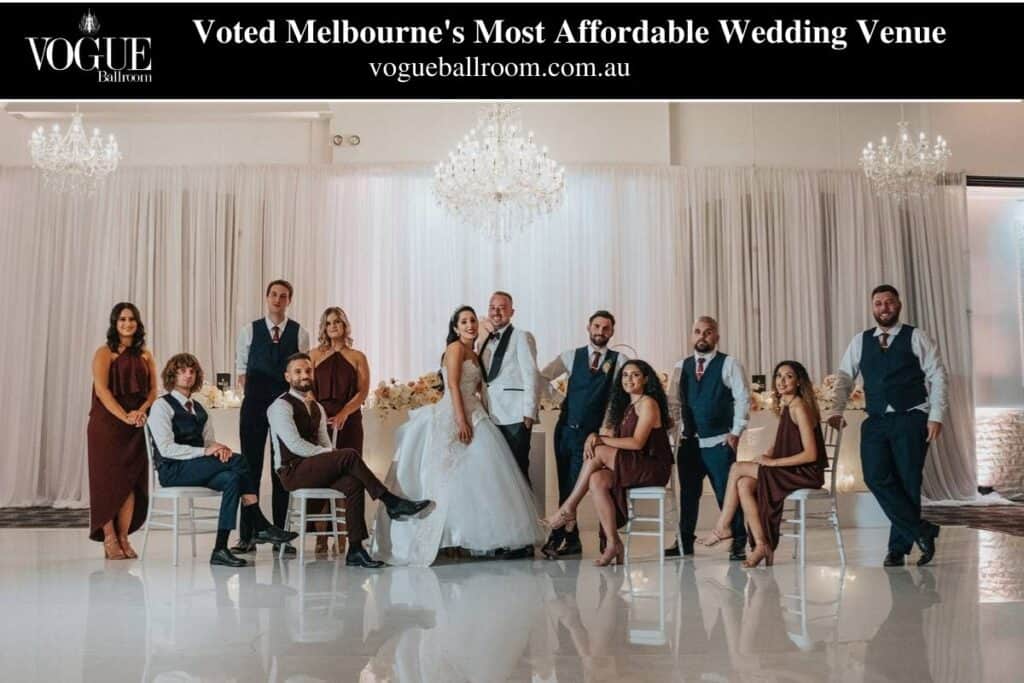Many brides follow tradition and wear a veil, but they are unsure of its significance or why. Learn more about the origins of the veil and its continued use in modern society.
Is a wedding veil something you're thinking about including in your big day's ensemble? In case you were wondering why brides traditionally wear veils, you've come to the right place!
A wedding veil can completely change a bride's look and make her wedding day even more memorable. Many future brides say it's the final touch on their perfect wedding day look. Yet, it begs the question: why do brides wear veils? Time to travel back in history and lift the wedding veil on countless age-old customs...
Although bridal fashions come and go, it appears that the veil will continue to be a required garment for the bride for the next several centuries at least. It's believed that the wearing of veils by brides on their wedding day originated for a few different reasons.
The veil was made to completely enshroud the bride's head and face as a representation of her virginity. Either the bride's father would remove the veil and show his daughter to her future husband, or the bridegroom would remove the veil and kiss his bride to symbolize the completion of the marriage.
Once a pivotal point in the wedding ritual, it is now a standard component of the bride's ensemble. A veil is a lovely accessory for the bride to wear on her wedding day. Most of the time, it's a matching tulle fabric to the dress, but it isn't required. Whether your preference is for a full-length ball gown or a shorter tea-length dress, it is the ideal final touch.
A bit later, we'll discuss the novel and updated ways in which modern-day couples observe this ritual. If you decide to wear a veil for your wedding, it will easily be one of your greatest prized possessions.
Also, the question of cost is bound to come up as you think about adding it to your wardrobe. Could you recommend a suitable fashion for me? How do you wear it? Whence did the custom initially arise, if at all? Keep reading to find out more about this fascinating custom and to have all of your questions about the wedding veil answered.
There have been many shifts in bridal garb over the years, but one constant is the traditional veil worn by the bride.
There may have been a time before white was the traditional colour for a bride's wedding gown, veil, and bouquet. No one knows for sure why women cover their faces, but many speculate that it has to do with a fear of evil spirits and demons, as was common among ancient Greeks and Romans.
Many aspects of the bridal ritual can be traced back to this belief, such as the practise of bridesmaids wearing dresses that look similar to the bride's in order to fool potential suitors. Brides wore bold colours like red and veils to either hide themselves from or scare away evil spirits.
However, the veil often obscured the bride's vision. The reason her father or whoever "gave her away" is because of this. He was walking alongside her to make sure she didn't stumble. In the case of an arranged marriage, the veil also served to protect the bride's anonymity from her future husband.
To view the bride first before wedding is considered extremely unlucky by superstition. The bride-to-be hid her face beneath a veil so that her future husband wouldn't get a glimpse of her until the big day.
Saying “I do” at Vines of the Yarra Valley is an elegant and luxurious affair.
Table of Contents
What does wearing a wedding veil symbolize?
Putting on a wedding veil is now seen as a modern bridal tradition that represents virginity and innocence by most women around the world. Additionally, for some women, wearing one is simply a symbol of passage that marks the beginning of their adult lives as a married woman.
Even though some brides decide not to wear veils, Sabatino advises all her clients to give the matter serious thought before making a final decision. She advises that you try on a few different styles to see which ones you like best, because your wedding day is the only time you'll ever be able to put on something like this.
In order to frighten away evil spirits
They were a superstitious lot, those ancient Romans. The veil was originally designed to protect the bride from spirits because people were so afraid of the supernatural.
The only way that could protect the bride from these demons was a red sheet called a "flammeum" that was draped over her head and shoulders. In addition to covering her face, the cloth acted as a disguise.
As a Symbol of Chastity and Subservience
It wasn't until the middle of the 18th century that white wedding dresses became popular, thanks to Queen Victoria's promotion of the colour as a symbol of innocence. The veil, however, has been around for a great deal longer.
The veil, representing modesty and respect, has been an integral part of religious rituals in many faiths, including Islam, Judaism, and Christianity. The veil has come to symbolise purity and submission because of the religious significance of weddings throughout history.
As well as their 'purity.' Agh. It's all about keeping things under wraps, and the veil is an allegory for the hymen. Unbroken veil, unbroken purity. In other words, you should go ahead and tie the knot.
Symbolic of the Groom's Dominance
The tradition of the father of the bride walking her down the aisle has been found to have some pretty dated undertones. Back in the day, when the veil was lifted to signify the transfer of control from the parent to the husband, the phrase "giving her away" had a much more literal meaning.
To put it another way: whoever opens the wrapping paper on a gift is the one who gets to keep it. It has long been customary for the bride's father to remove the veil from his daughter's face before she is "gifted" to her future husband.
It is traditional for the groom to remove the veil just prior to the wedding, signifying his intention to claim the bride as his wife.
So That the Bride Won't Get Away
The veil was apparently designed to obscure the bride's vision and limit her range of motion so that she could not escape her arranged marriage. According to Bustle, brides also kept their wedding dress trains long because of the same reason. Is patriarchy the best system?
A bride's veil is there to cover her face.
A new theoretical preference for brides wearing veils to conceal their identities emerged out of the remains of the spiritual confusion. This time, though, she wasn't trying to hide her identity from ghosts; she was just trying to avoid her future husband seeing her face.
Fathers who arranged marriages for their daughters often hid their identities until the very end of the ceremony, so that the exchange of a less enticing bride for goods and money wouldn't be spoiled. How cute! In time, this evolved into the "cute" custom of men not being allowed to see their bride until the big day. Sounds like a romantic comedy, right?
Check out our post on How do I look good in a mermaid wedding dress?
Wedding veils symbolise the depth of a bride's feelings for her groom.
To put it another way: whoever opens the wrapping paper on a gift is the one who gets to keep it. It has long been customary for the bride's father to remove the veil from his daughter's face before she is "gifted" to her future husband. It is traditional for the groom to remove the veil just prior to the wedding, signifying his intention to claim the bride as his wife.
Alternate choices for veils
If you want to make the custom of the bride wearing a veil to her wedding unique and contemporary, there are many different routes you can take.
The possibility of having the veil blow in your face down the aisle is a common reason why people choose not to wear one. Many contemporary brides have swapped them out for something more in tune with the occasion, such as tiaras, statement headpieces, eye-catching hair accessories, or flower crowns.
You can also take a cue from these brides by accessorising your special day with a veil. If the cost is prohibitive, you can make your own veil out of tulle and a hair clip.
It's perfectly acceptable if a woman chooses not to cover her face in public. Not following the custom will not make you appear less bride-like. It is, in fact, your special day. Maintain your own sense of style.
Wedding veils, whether worn by a modern or traditional bride, can make even the most understated dress look like a million dollars. You can choose a veil with a bit more detail and lavishness if you have passed with a more simple dress.
Layers of lace, appliqué, and floral embroidery — sigh. We recommend a simple, yet stunning, veil if your dress is already sure to attract attention. Always keep in mind that the purpose of your veil is to draw attention to the beauty of your wedding dress.
You should also think about whether or not your wedding day hairstyle will look good with a veil. You can wear a veil for either traditional or aesthetic reasons. That you feel absolutely fantastic while donning it is the most crucial factor.
Check out our list of Wedding Dress Shops in Melbourne to help you select your ultimate gown.
Conclusion
The bride looks stunning in her veil on her special day. The tulle fabric is typically the same as the dress, but this is not necessary. Symbolic of her innocence, the veil was designed to cover the bride's entire body, including her face.
A modern bridal tradition, the veil is seen by most women as a symbol of purity and innocence. For other women, it's merely a rite of passage into adulthood as a wife and the act of putting one on marks the beginning of her new life as a woman.
Even though Sabatino acknowledges that some brides may opt to forego a veil, she encourages all of her customers to give the topic careful consideration prior to making a final decision.
The veil's original purpose was to keep evil spirits away from the bride. In many religions, including Islam, Judaism, and Christianity, the veil is worn during worship services as a symbol of modesty and respect.
Due to the religious significance of weddings throughout history, it has come to symbolise innocence and subjection. So that the exchange of a less desirable bride for goods and money wouldn't be spoiled, fathers who arranged marriages for their daughters often remained anonymous until the very end of the ceremony.
This eventually became the "cute" tradition of grooms not being able to see their bride until the wedding day. In today's society, women who choose not to wear face coverings in public do not draw unwanted attention to themselves.
It's not necessary to follow the tradition if you don't want to look like a bride. Continue to express your own personal flair. If you are able to get away with a simple dress, you are free to select a veil with more detail and lavishness.
Content Summary
- Once a pivotal point in the wedding ritual, it is now a standard component of the bride's ensemble.
- A veil is a lovely accessory for the bride to wear on her wedding day.
- There have been many shifts in bridal garb over the years, but one constant is the traditional veil worn by the bride.
- There may have been a time before white was the traditional colour for a bride's wedding gown, veil, and bouquet.
- No one knows for sure why women cover their faces, but many speculate that it has to do with a fear of evil spirits and demons, as was common among ancient Greeks and Romans.
- Brides wore bold colours like red and veils to either hide themselves from or scare away evil spirits.
- However, the veil often obscured the bride's vision.
- In the case of an arranged marriage, the veil also served to protect the bride's anonymity from her future husband.
- Putting on a wedding veil is now seen as a modern bridal tradition that represents virginity and innocence by most women around the world.
- In order to frighten away evil spirits
- The veil was originally designed to protect the bride from spirits because people were so afraid of the supernatural.
- The veil, representing modesty and respect, has been an integral part of religious rituals in many faiths, including Islam, Judaism, and Christianity.
- The veil has come to symbolize purity and submission because of the religious significance of weddings throughout history.
- The tradition of the father of the bride walking her down the aisle has been found to have some pretty dated undertones.
- It has long been customary for the bride's father to remove the veil from his daughter's face before she is "gifted" to her future husband.
- It is traditional for the groom to remove the veil just prior to the wedding, signifying his intention to claim the bride as his wife.
- The veil was apparently designed to obscure the bride's vision and limit her range of motion so that she could not escape her arranged marriage.
- According to Bustle, brides also kept their wedding dress trains long because of the same reason.
- A new theoretical preference for brides wearing veils to conceal their identities emerged out of the remains of the spiritual confusion.
- Fathers who arranged marriages for their daughters often hid their identities until the very end of the ceremony, so that the exchange of a less enticing bride for goods and money wouldn't be spoiled.
- In time, this evolved into the "cute" custom of men not being allowed to see their bride until the big day.
- It has long been customary for the bride's father to remove the veil from his daughter's face before she is "gifted" to her future husband.
- It is traditional for the groom to remove the veil just prior to the wedding, signifying his intention to claim the bride as his wife.
- If you want to make the custom of the bride wearing a veil to her wedding unique and contemporary, there are many different routes you can take.
- Maintain your own sense of style.
- We recommend a simple, yet stunning, veil if your dress is already sure to attract attention.
- Always keep in mind that the purpose of your veil is to draw attention to the beauty of your wedding dress.
- You should also think about whether or not your wedding day hairstyle will look good with a veil.
- You can wear a veil for either traditional or aesthetic reasons.
Frequently Asked Questions About Wedding Veil
The range / average cost of a wedding veil is anywhere from $100 to $800, but generally around $250 to $400 is the average cost.
The wedding veil probably originated as a way to ward off evil and protect the purity of the bride. The veiling of the bride has origins in the idea that she's vulnerable to enchantment, so she must be hidden from evil spirits. The Romans veiled brides in flame-colored veils to actually scare off those spirits.
The most common method is for the father to raise the blusher of his daughter's veil when they reach the altar, and then hand her off to the groom. The second option is to leave the veil down during the entire ceremony until pronouncement of husband and wife. The groom then lifts the veil and kisses his bride.
Most will say that the cathedral veil should not just match the length of your train but extend at least an additional 5”at least. We suggest wearing it with (at the very minimum) a gown that meets the floor for an extra dramatic affect.




